Electronic pet behavior correction tools, like handheld dog deterrents or remote trainers, use electric pulses or sound waves to correct unwanted behaviors in dogs. These devices, with adjustable intensity levels and training modes, promote positive behavior through immediate feedback. Effective carrying methods, such as belt loops or car mounts, enhance control and impact during training sessions. Safety and ethics are paramount; these tools should be used responsibly after traditional methods fail, with proper handling, maintenance, and calibration to prevent harm.
Electronic pet behavior correction tools, like handheld dog deterrents, have emerged as innovative training aids. These devices utilize safe, non-violent stimuli to correct unwanted behaviors in dogs, promoting positive reinforcement training methods. Understanding their design and functionality is crucial for effective use. This article explores various handheld dog deterrent devices, ideal carrying methods, and essential safety precautions and ethical considerations surrounding these tools.
- Understanding Electronic Pet Behavior Correction Tools
- Handheld Dog Deterrent Devices: Design and Functionality
- Carrying Methods for Effective Training Aids
- Safety Precautions and Ethical Considerations
Understanding Electronic Pet Behavior Correction Tools
Electronic pet behavior correction tools, also known as remote trainers or static shock collars, are innovative devices designed to help train and correct unwanted behaviors in pets, particularly dogs. These tools use electric impulses or sound waves to communicate with animals, offering a modern alternative to traditional punishment methods. By using handheld devices, owners can deliver precise corrections from a distance, making it easier to manage and modify behavior during walks or in various settings.
The effectiveness of these tools lies in their ability to provide immediate feedback, allowing pets to understand the connection between their actions and the subsequent response. Handheld dog deterrent carrying methods vary, with some models offering different intensity levels and training modes, catering to diverse pet needs. This technology is particularly useful for addressing issues like barking, pulling on leashes, or jumping on people, promoting better pet behavior through positive reinforcement and consistent training.
Handheld Dog Deterrent Devices: Design and Functionality
Handheld Dog Deterrent Devices, often referred to as bark collars or remote trainers, are innovative tools designed to address unwanted pet behaviors through gentle correction. These devices typically consist of a small, portable transmitter and a receiver worn by the dog, connected via a collar or harness. The handler operates the transmitter, emitting a low-level electronic pulse when the dog exhibits specific behaviors, such as excessive barking or jumping. This instant feedback serves as a deterrent, encouraging positive behavior changes over time.
The design of Handheld Dog Deterrent Devices focuses on portability and ease of use. They are designed to be comfortable for dogs, with adjustable collars or harnesses that accommodate different sizes and breeds. The transmitter often includes various intensity settings, allowing trainers to customize the level of stimulation based on their dog’s sensitivity and behavior goals. This versatility is crucial in ensuring safe and effective training without causing harm or stress to the animal.
Carrying Methods for Effective Training Aids
When it comes to electronic pet behavior correction tools, the way you carry and present them can significantly impact their effectiveness during training sessions. Handheld dog deterrent devices, for instance, are best utilized when they’re securely and comfortably held in your hand or attached to a belt loop. This ensures ready access and allows for quick, precise activation when needed, which is crucial for maintaining control and discipline.
Different carrying methods cater to various activities and pet types. For instance, during walks, a secure clip-on or belt-mounted holder can keep the device close at hand while allowing both you and your dog freedom of movement. In cars, a sturdy mount that won’t shift or fall can be invaluable, as it prevents accidental activation and keeps the focus on desired behavior. Choosing the right carrying method for your specific training scenarios will enhance the tool’s impact, making it an integral part of your pet’s behavior correction arsenal.
Safety Precautions and Ethical Considerations
When using an electronic pet behavior correction tool, such as a handheld dog deterrent, it’s paramount to prioritize safety and adhere to ethical standards. These devices emit safe but powerful signals that can effectively correct unwanted behaviors like barking or aggression. However, proper handling is crucial; users should follow manufacturer guidelines regarding frequency and intensity settings to avoid causing discomfort or distress. Ethical considerations demand that these tools be employed as a last resort after traditional training methods have been exhausted, and only by responsible owners committed to positive reinforcement.
Handheld Dog Deterrent Carrying Methods play a role in ensuring safety during use. Users should keep the device out of reach of children and pets, store it securely when not in use, and transport it responsibly to avoid accidental activation or loss. Regular maintenance and calibration of the device are also essential to guarantee its reliability and prevent potential harm.
Electronic pet behavior correction tools, particularly handheld dog deterrents, offer a modern approach to training. By understanding their design, functionality, and safe use through appropriate carrying methods, pet owners can effectively address unwanted behaviors while adhering to ethical guidelines. Incorporating these devices into training regimens requires careful consideration, ensuring the well-being of pets and the effectiveness of correction techniques.
